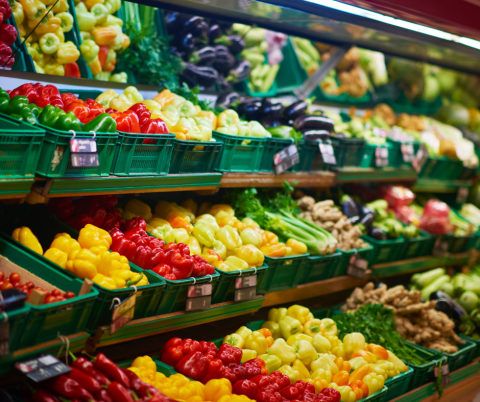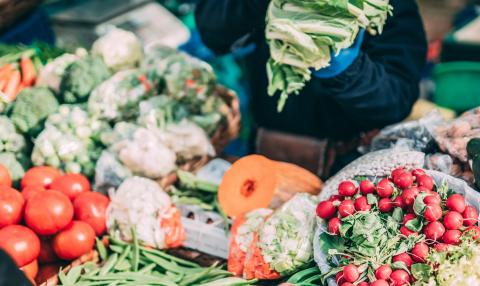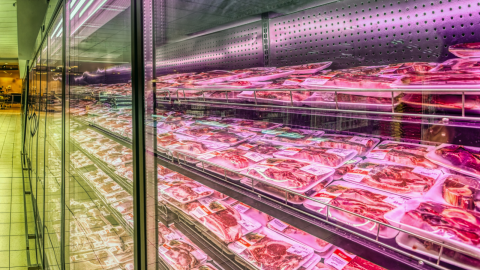14 July 2025
UK still failing to meet basic dietary guidelines

Following the release of new National Diet and Nutrition Survey (NDNS) data our Research Lead Holly Cooper finds the UK is still failing to meet basic dietary guidelines
New data shows that fruit and vegetable consumption in the UK is falling to even lower levels, with fewer than one in ten 11-18 year-olds eating their five-a-day. Fibre intake is even more concerning, with just 4% of adults meeting the recommended intake.
The recently-released National Diet and Nutrition Survey (NDNS), covering the years 2019–2023, offers a vital snapshot of diets during a period shaped by COVID-19 and the cost-of-living crisis. While the change in methodology means we cannot make exact comparisons to previous years(1), we can still observe several worsening trends.
Are we eating our five-a-day?
No - and the gap is growing.
Low fruit and vegetable intake has long been a challenge in the UK, but the latest NDNS data suggests the situation is worsening. Only 9% of 11-18 year-olds meet the five-a-day target - the lowest of any age group. No age group meets the recommendation, though older adults (65+) in the highest income decile come closest.
Fruit and vegetable intake is correlated with income. The most deprived children eat almost one less portion of fruits and vegetables a day compared to the least deprived. Given this correlation with income, the cost of living crisis that began in late 2021 likely worsened this dietary inequality.
See The Food Foundation Peas Please campaign for more analysis on decreasing vegetable purchases in the UK which paint a similarly worrying picture of declining fruit and vegetable consumption.
Are we getting enough fibre?
Again, the answer is no.
Fibre intake still remains critically low across all age groups, especially among adults. Only 4% of adults meet the recommended 30g of fibre per day - a figure that drops to just 1% among women aged 65 and over.
The percentage of the following age groups are NOT meeting fibre recommendations:
- 18 months to 3 years → 78%
- 4 to 10 years → 86%
- 11 to 18 years → 96%
- Aged 19 or over → 96%
Women generally consume less fibre than men. Yet even among older men, intake is far from ideal: only 8% of men aged 65-74 meet recommendations.
This has major implications for public health. Fibre is crucial for preventing obesity, type 2 diabetes, and some cancers. It must become a priority for government intervention.
Income again plays a role: a £10,000 rise in income among men aged 65-74 correlates with 0.8g more fibre per day. For children, an equivalent rise in income resulted in a more modest increase in fibre of 0.3 to 0.4g per day.
Interestingly, ‘cereals and cereal products’ (e.g. bread, pizza, breakfast cereals) are the main source of fibre (43%–50% of intake). These are often inferior sources of fibre when compared to, for example, vegetables and pulses, since they can also contain high levels of free sugars.
Are we eating less red and processed meat?
On average, yes — but there’s more to the story.
NDNS data shows a welcome decline in red and processed meat consumption. Average male and female intake has fallen since data was last collected, and both are now below recommended levels of 70 grams a day – roughly two slices of bacon.
But the averages mask a significant issue: a large proportion of people, particularly men and boys, are still eating well above safe levels of red and processed meat.
- Men aged 19 to 64 eat 66 grams per day on average (just 4 gram below the recommended daily intake).
- Nearly one in three (27%) of men between the ages of 19 and 64 consume more than 90 grams per day, which is well in excess of recommended limits.
- Similarly for boys between the ages of 11 and 18, more than 1 in 5 eat more than 90 grams per day (22%).
- To put this gender imbalance into perspective, only 3% of girls between the ages 11 to 18 are eating more than 90 grams per day.
In terms of how this fits into the broader trends on meat consumption, the NDNS data shows that overall, adults are slightly reducing their meat intake, whereas in contrast children are slightly increasing theirs since data was last collected.
See The Food Foundation Meat Facts for more analysis on UK meat consumption.
Has the sugar tax worked?
There is some good news on sugar.
Consumption of sugar-sweetened soft drinks has dropped significantly for children between the age 11 to 18 which may be partly attributable to the impact of reformulation taxes (formally the Soft Drinks Industry Levy).
This tax came into effect partway through the last data collection period of 2014- 2019, when a drop in consumption for this age group was also seen. This chimes with newly released government data showing a 40% decrease in sales volume of drinks falling within the threshold of the soft drinks levy (5 grams or more sugar per litre) between 2015 to 2024.(2).
But overall sugar intake remains far too high. The recommended maximum for free sugars is 5% of daily energy intake. Yet this was not met by:
- 73% of those aged 18 months to 3 years
- 92% of those aged 4 to 10 years
- 95% of those aged 11 to 18 years
Interestingly, for all age groups, the largest contributor to sugar intake is ‘cereals and cereal products’ providing 29% to 40% of free sugars intake. Given this is also the leading source of fibre in UK diets, this highlights the need for smart policy interventions that reduce sugar intake without worsening already-low fibre intake.
What proportion of food is prepared and eaten at home?
Most eating happens at home – 87% of what the data terms ‘eating occasions’ – and 10% of ‘eating occasions’ happening outside the home. Despite the NDNS data covering COVID-19 lockdowns and a cost of living crisis, still 12% of calories consumed come from out of home food between 2019-2023.
Where out of home food comes from is mixed:
- 23% of adults report buying food from fast food or takeaway outlets, but this is highest among 11-18 years olds, of whom 30% report buying food in this way.
If we zoom into school age children, we find the following:
- 12% of 16-18 year olds buy lunch outside of school at a shop or café
- 38% of children bring in a packed lunch to school
- 1% do not have lunch at school
- 22% receive universal free school meals; another 8% receive free school meals outside this programme.
That such a high proportion of out of home food is coming from fast food and takeaway outlets is a concern given that this is likely to be negatively influencing several health problems linked to the overconsumption of calories, salt and saturated fat.3
Conclusion: A call to action
There are glimmers of hope in this data - falling sugary drink intake and continued reductions in red and processed meat consumption at a population level. But much of the picture is deeply concerning.
- 96% of adults don’t meet fibre recommendations
- 91% of 11-18 year-olds fall short of the five-a-day target
- Nearly one in three 19-64 year-old men consume more than 90 grams of red and processed meat per day – a known carcinogen – and well above the recommended limit of 70 grams per day
Food Foundation Research Lead Holly Cooper concludes: "That so few in the UK are achieving the government’s basic dietary requirements for good health is an urgent call to action for our government. We need a national Food Strategy that improves access to healthy and sustainable diets - particularly for the lowest-income households.
"Only then can the government truly deliver on their promises to raise the healthiest generation of children ever, halve the gap in healthy life expectancy between the richest and poorest, reduce child poverty, end the need for food banks and reach Net Zero goals"






